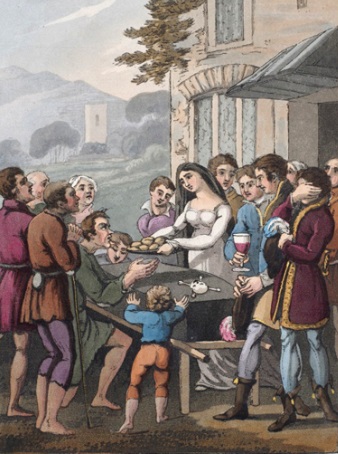Summary | Excerpt | Reading Guide | Reviews | Beyond the Book | Read-Alikes | Genres & Themes | Author Bio

A Novel
by Elizabeth StroutThis article relates to Tell Me Everything
 In Elizabeth Strout's novel Tell Me Everything, the author discusses the concept of the modern-day "sin-eater." In her interpretation, the term applies to a person who helps others unburden themselves of their guilt or emotional pain, allowing them to move forward with their lives. In England, Scotland, and Wales, however, "sin-eater" was an actual profession. In the 18th and 19th centuries, impoverished people could be hired to eat the sins of the recently deceased.
In Elizabeth Strout's novel Tell Me Everything, the author discusses the concept of the modern-day "sin-eater." In her interpretation, the term applies to a person who helps others unburden themselves of their guilt or emotional pain, allowing them to move forward with their lives. In England, Scotland, and Wales, however, "sin-eater" was an actual profession. In the 18th and 19th centuries, impoverished people could be hired to eat the sins of the recently deceased.
There are several theories as to how the practice arose. Some point to the use of a scapegoat as outlined in the Bible (Leviticus 16:8-10), where a goat was burdened with the sins of the Jewish people and sent off into the wilderness during the Yom Kippur (Day of Atonement) ritual. Others cite the medieval custom of nobles distributing food to commoners in exchange for prayers for the dead. It's also possible that in the predominantly Protestant countries sin-eating substituted for Catholic indulgences, which were bought to help release a soul from purgatory and allow them to ascend to heaven.
Regardless, sin-eating was a well-established custom by the 1680s. The hired man — it was almost always a man — would sit in front of the body as one might sit at a table. Bread, thought to be able to absorb the dead person's misdeeds, was then placed on the corpse's midsection. The sin-eater would be given a mug of ale, and as the deceased's loved ones watched, he'd consume the bread, thereby taking the dead person's sins into himself. He'd typically be paid about four pence for his service — just a few dollars in today's economy.
During the time sin-eating was common, the concepts of sin, heaven, and salvation were much more a part of daily life than they are for most today. Consequently, only the most desperate people were willing to become sin-eaters, and they were looked down upon by the general public as a result of their profession. It was felt that these individuals were throwing away their own salvation for short-term gain here on earth.
The practice died out around the end of the 19th century, in part because of strong condemnation by religious leaders. The last professional sin-eater is thought to have been Richard Munslow (1832-1906). He was the exception in that he was a well-respected farmer rather than a social pariah. It's believed that he became a sin-eater out of grief over the deaths of his four children (three in the same week).
The phrase has seen a recent resurrection, although there's no longer any actual eating involved. A modern-day sin-eater is someone who selflessly witnesses the worst society has to offer so that the rest of us don't have to. One example often cited is the people who moderate social media sites; their job is to screen flagged content that can, at times, be truly horrendous (a recent article in Psychology Today discusses how many of them deal with PTSD). First responders, too, are subjected to gruesomeness on a daily basis that most of us will never have to see. Therapists and counselors are considered sin-eaters because they help their clients heal emotionally by absorbing their burdens (the sense employed by Strout). Some also consider lawyers, who are paid to remove the "sins" of their clients, to be sin-eaters, although depending on the situation, their motives may be less altruistic than those of the others mentioned.
Illustration of a sin-eater from The Popular Antiquities of Wales, 1815, courtesy of SPL Rare Books
Filed under Cultural Curiosities
![]() This "beyond the book article" relates to Tell Me Everything. It originally ran in October 2024 and has been updated for the
September 2024 edition.
Go to magazine.
This "beyond the book article" relates to Tell Me Everything. It originally ran in October 2024 and has been updated for the
September 2024 edition.
Go to magazine.
Your guide toexceptional books
BookBrowse seeks out and recommends the best in contemporary fiction and nonfiction—books that not only engage and entertain but also deepen our understanding of ourselves and the world around us.